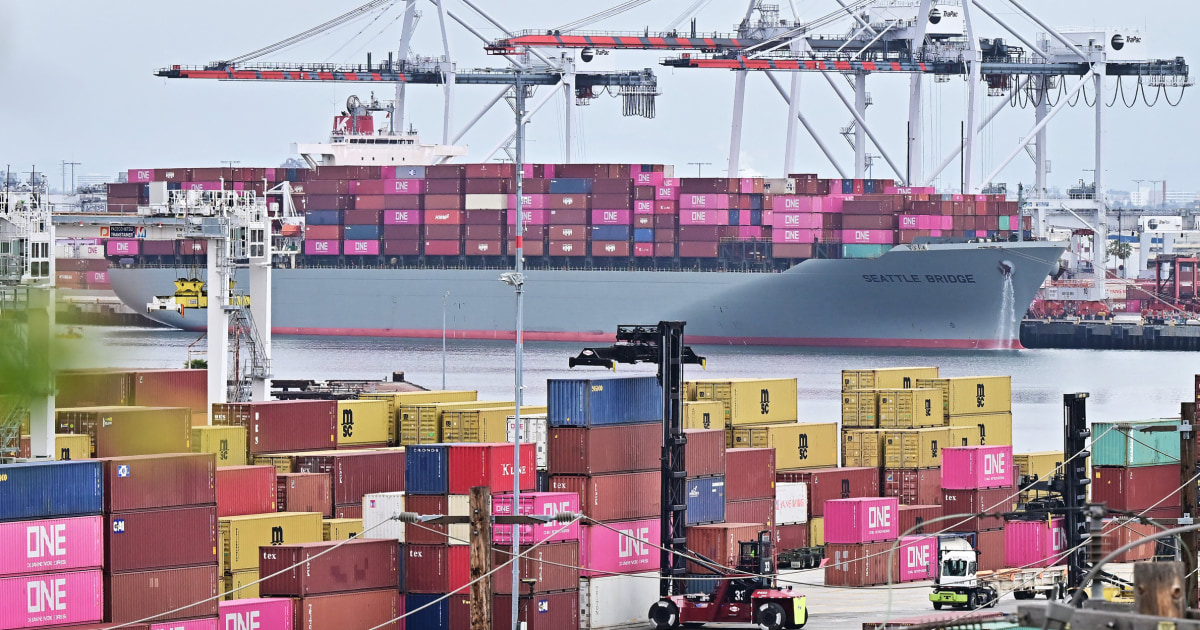U.S. companies surge shipments from China following tariff pause

Businesses have begun ramping up shipments to the United States from China after President Donald Trump paused some of his tariffs on imports from that country, creating a surge in demand that could lead to supply chain bottlenecks in the coming months.
Freight bookings out of China increased nearly 300% this week compared to the week earlier, soaring to the highest levels of the year, said Ben Tracy, vice president of strategic business development at Vizion, a company that produces container-tracking software. That came after Trump announced Monday that he was reducing the tariff on Chinese imports for 90 days while Washington and Beijing continue trade talks.
U.S. companies halted shipments and canceled orders last month, when Trump ratcheted up his tariffs on Chinese imports to more than 145%, making it unaffordable for many companies to import their goods. While Chinese imports still face a 30% tariff, companies appear to be taking advantage of the 90-day pause on the higher tariffs to catch up on delayed shipments and get as many products into the U.S. as they can at the relatively lower rate.
“Over the past month, we saw a huge drop off in trans-Pacific trade, especially from China, dropping by 60% or more in terms of those volumes,” said Jessica Dankert, vice president for supply chain at the Retail Industry Leaders Association. “So now that we have at least relative certainty for the 90-day window, we definitely expect to see those volumes ramp back up again.”
But despite the pause to some tariffs, companies aren’t expecting smooth sailing in the coming months.
It can typically take around a month for goods to travel from China to the U.S., but a surge in demand and limited numbers of ships, port docking space and trucks to transport goods could add up to several additional months of time, said Bryan Gross, a principal at PwC who works on supply chain issues.
“There’s only a certain amount of capacity in that pipe, it can only expand so far. There’s only a certain number of container ships. There’s only a certain number of appointments in the ports to be able to consume that capacity,” he said. “That bubble of goods is going to start flowing through the system, but it’s constrained by the size of the pipe.”
That supply and demand imbalance could also lead to higher shipping rates, which have already jumped in recent days.
Because it can take several months for a ship to travel to the U.S. then back to China, an increase in ships leaving China in the coming days and weeks could lead to a shortage of container ships available this summer, which is the peak time for retailers to be shipping their back-to-school and holiday merchandise.
“What may be an issue is that in two months time, which would be peak season for retail, we might not have enough containers available in China to load, and not only containers, but also not enough ships there,” Tracy said.
For other industries, it could already be too late to get the goods in time for their peak season. U.S. fireworks importers halted many of their shipments coming from China in April because they couldn’t afford the higher tariff rates, said Julie Heckman, executive director of the American Pyrotechnics Association.
While the China tariffs remain a significant cost at 30%, companies have started to resume shipments, she said. But it will likely be too late for some to get their goods in time for Fourth of July, resulting in shortages of certain products.
“Everybody is scrambling now to try to take advantage of the 90-day pause. But those sailings, the bookings take a while. It’s not like you just flick a light switch and everything is back on,” Heckman said. “Companies are making those arrangements, they’re going to try to get in what they can, but some of that’s probably going to come after the Fourth of July.”
There could also be consequences for next year, when America is celebrating the 250th anniversary of its independence and the fireworks industry was expecting a surge in demand. Many fireworks companies halted their production in China during April as a result of the uncertainty around the tariffs. While some have restarted that production, they have lost valuable manufacturing time during a limited window when Chinese companies can produce fireworks for the U.S. market, Heckman said.
Retailers also remain concerned about the longer-term impact that tariffs could have on their businesses as they try to plan for the coming months.
“Now that we have a window of a bit more certainty for the immediate future, there’s the ability to plan a little bit more and try and get some of the more critical goods in production and on the water and brought into the U.S.,” Dankert said. “But I think looking long term, what the business and what the industry really needs is the sense of stability and the kind of certainty going forward to make those longer decisions around ordering.”
